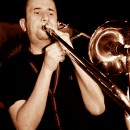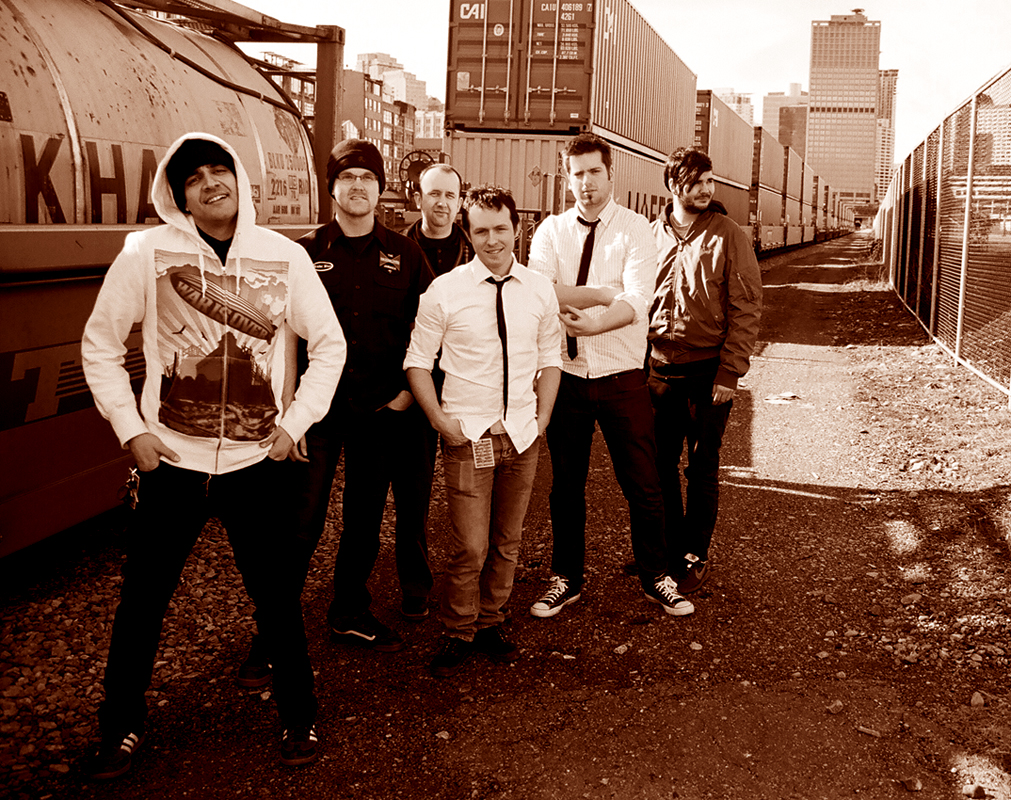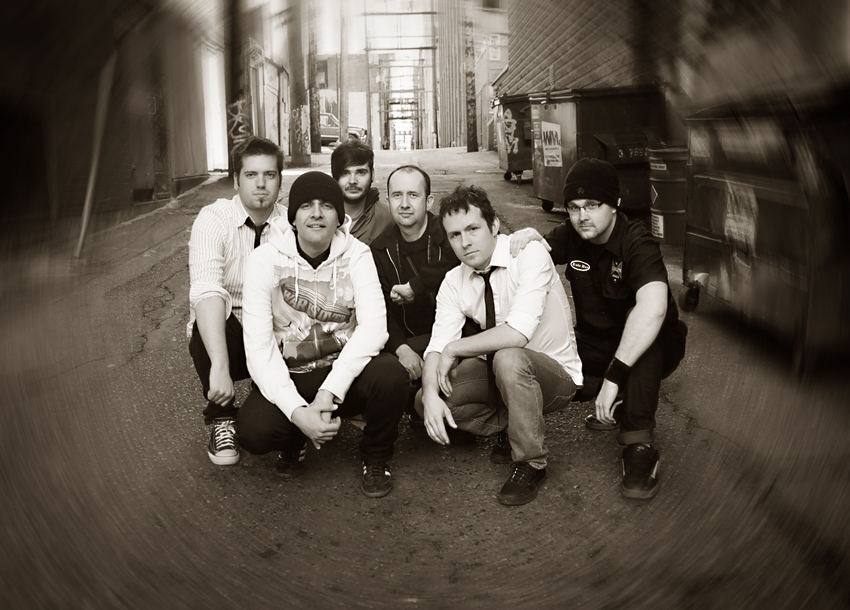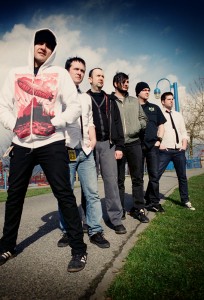 Few Current Day Punk Rock Bands Build Music Around “The Afterbeat”
Few Current Day Punk Rock Bands Build Music Around “The Afterbeat”
story by : Tamara Lee photos by : Tamara Lee previously published : Discorder Magazine
The scene was completely raw. The bar was dimly lit and smelled like the regulars who sat around in the shadows. I stood in front of a feeble attempt at a stage, only one foot above the floor. When I moved my feet I noticed they were sticking to some mystery puddles, which I hoped was beer but maybe was—I try not to think about it.
This is Pat’s Pub and I am here to see the Afterbeat, a six-piece ska/punk band from Winnipeg. They are playing their first show on a cross-Canada tour. As I survey the Pat’s crowd, I observe a strange mixture of punk-rock seniors (still in skinny jeans and mohawks since the ’80s), some classic rockabilly folk (Betty Page pin-up girls and plaid ’50s greasers), and those trusty regulars, still enjoying their 2 p.m. beer break. Pat’s has the air of the Ivanhoe. This means bad carpeting and rickety wooden chairs, with an over arching bathroom smell. The only thing missing is random cheese sales by the customers.
 However, I am soon able to forget the whole sordid scene, which becomes insignificant once the Afterbeat takes the stage. The music begins with a slap to our collective cheeks, and within notes they manage to punch the entire crowd into a frenzy. At first verse, they lay out a high-energy foundation layer with a bouncing guitar line atop some funky base. The rhythm has a powerful reggae swing to it. Just when we are all bouncing on the balls of our feet, they kick it into double time and come over the top with the chorus, sweeping up anyone left who had not been moving. The lead vocals ring out about “rude boys” and “changing the system,” backed up by all the boys and their “woah oh”s. And the final icing is the sweetly added sounds of harmonic horns, energizing the chorus with bouncy trombone and trumpet.
However, I am soon able to forget the whole sordid scene, which becomes insignificant once the Afterbeat takes the stage. The music begins with a slap to our collective cheeks, and within notes they manage to punch the entire crowd into a frenzy. At first verse, they lay out a high-energy foundation layer with a bouncing guitar line atop some funky base. The rhythm has a powerful reggae swing to it. Just when we are all bouncing on the balls of our feet, they kick it into double time and come over the top with the chorus, sweeping up anyone left who had not been moving. The lead vocals ring out about “rude boys” and “changing the system,” backed up by all the boys and their “woah oh”s. And the final icing is the sweetly added sounds of harmonic horns, energizing the chorus with bouncy trombone and trumpet.
And I think to myself, this is punk music in its purest form. It resembles nothing like what we are calling punk today…. no sign of Sum 41, Good Charlotte or Fall Out Boy. There is not the predictable mass marketed punk style, with its not-so-dangerous high school rebellions and angst about girlfriends and math 10. If we shed away all of today’s clichés, then were left with what is before me: something closer to the core roots of punk rock,  like what we left behind in the mid 90’s.
like what we left behind in the mid 90’s.
Current day pop-punk has deviated so far from its roots that it is barely recognizable from its beginnings. Exactly where and when the punk rock’s first emergence took place is probably debatable. One could more specifically pin point which bands were some of the genre’s first pioneers. During the mid to late 70’s, The Sex Pistols and The Clash started making new waves in Britain. Concurrently, in New York, The Ramones and The Talking heads started to gain popularity around the scene. Though these bands showed a diverse range of sounds, original punk music commonly contained at least one of two key factors. These are:
1) It was Political. This began as a reactionary counter culture to the problems of the times. The songs contained social and economic commentary wrapped up in an angst ridden punk rock package.
2) The music had OI factor. There was a certain bounce to it, usually accompanied by horns, and a little flavor of reggae. This was largely because right around the birth of punk rock in Britain, there was another political movement coming directly from Jamaica. That is Ska.
Ska music was another socio-economic reaction, born in the fifties by a culture of rebels known as the Rude Boys. Though it is less known, ska music is actually the influential older sibling to reggae music., pre-dating it by at least a decade. In the mid 70’s, this movement finally crossed water to England, running squarely in to the fresh punk scene. With similar rebellious roots and direction, this was a logical union, and a new sound began as artists re-released older ska classics in new punk-fusion style. Some well know artists on this scene were The Specials, The Beat, Skatalites and Madness. This “Second Wave” of ska music was often referred to as two tone, names after a record label that signed many of these pioneering artists. These influences also continued into newer styles as punk evolved into the late 80’s and 90’s. Ranging from heavy ska-styled sounds of Operation Ivy, Rancid and Reel Big Fish to bouncy Californian surfer punk, like NOFX, 311 and Sublime.
Throughout the years, punk rock music passed through many changes and styles. Through each reinvention, however, there remained some semblance of its origins. That is, until about the mid 90’s, when a final irreparable change took place. It might be harsh to say that The Offspring or Green Day is entirely responsible for this new turn, as they may have been on the crest of some inevitable wave. But in 1994, when Green Day’s album Dookie sold a record-breaking 15 million copies, the changes were certainly set in motion.
Imagine how the industry’s top dogs must have been salivating at these new prospects. An edgy, blue-haired garage band becoming the next mass-marketable goldmine. Before long, these sounds were in pop production. OI was lost to unoriginal power chords. Horns went back to their cases. Social commentary was smoothed over into safer topic matter and eventually we found “punk rock” filling the top 40 charts.
 Nowadays it is challenging to find any punk music with the original styles and sounds, although it is out there. The Afterbeat is part of this small remaining tribe, and has toured with kindred bands, such as Bedouin Soundclash, Bad Brains, The Skatalites and Catch 22. They have also been highly praised by Ska-T’s Scenic Drive on CiTR as a rare gem of the genre. (UBC’s radio station at 101.9 in Vancouver)
Nowadays it is challenging to find any punk music with the original styles and sounds, although it is out there. The Afterbeat is part of this small remaining tribe, and has toured with kindred bands, such as Bedouin Soundclash, Bad Brains, The Skatalites and Catch 22. They have also been highly praised by Ska-T’s Scenic Drive on CiTR as a rare gem of the genre. (UBC’s radio station at 101.9 in Vancouver)
I caught up later with Mike Reis, singer and guitarist for The Afterbeat. We talked a little about the birth of Reggae and Ska.
Reis- “..back in the 50’s in Jamaica, one drummer began to hit on the second beats of the rhythm instead of the first. It’s a simple change. But this emphasis on the off beats made a whole new sound entirely. Ska was born and music was built around The Afterbeat.”
Their name is a suitable tip of the hat to the music that they clearly love. And this affection translates into producing great music of a genre. That is exactly what The Afterbeat gives us, wrapped into a fun, high-energy show.
Just when I had thought that punk music had been swallowed by giant record labels and spat out at teenage masses…. I am relieved to find that in some dingy bar’s shadows, original ska influenced punk rock is still being born back into its pure form. Thank you Afterbeat.